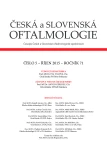Solar Maculopathy after Watching the Partial Solar Eclipse
Authors:
P. Kristian 1; J. Timkovič 1,2,3; D. Cholevík 1,2,3; V. Dedek 1
Authors‘ workplace:
Oční klinika, Fakultní nemocnice, Ostrava, přednosta MUDr. Petr Mašek, CSc.
1; Lékařská fakulta, Ostravská univerzita, Ostrava
2; Lékařská fakulta, Masarykova univerzita, Brno
3
Published in:
Čes. a slov. Oftal., 71, 2015, No. 5, p. 253-258
Category:
Original Article
Overview
Aim:
To describe clinical findings in patients with sudden decrease of visual functions according to the solar maculopathy appearance after watching the partial solar eclipse and results of the changes’ follow-up after 7 weeks.
Material and Methods:
Medical records of five women (6 eyes) with solar maculopathy associated with watching partial solar eclipse on March 20th, 2015 were retrospectively evaluated. The diagnosis of solar maculopathy was established according to the medical history, ophthalmologic examination of the fundus in artificial mydriasis, and confirmed by means of spectral domain optic coherence tomography examination of the macula. The follow-up period of the patients in the study group was 7 weeks.
Results:
All patients described the presence of relative central scotoma and decrease of the central visual acuity (VA) of different extension in the involved eye. The average best-corrected visual acuity (BCVA) of women in our group was 6/9 (range, 6/6 partially – 6/18). In one patient, the involvement was bilateral, in the other cases the involvement was unilateral. The biomicroscopic examination of the fundus revealed yellowish to yellow-whitish lesions with brightness of the pigment layer in the center of the foveola in all patients. The optic coherence tomography examination of the macula confirmed the irregularities of the retinal pigment layer and photoreceptors outer segment with hyper-reflective focus of the neuroretina in the center of the foveola.
Conclusion:
During the follow-up period, we recorded improvement of the central visual acuity in all women with unilateral involvement. In the woman with bilateral retinal involvement, the best-corrected visual acuity of the right eye remains without any improvement. The optic coherence tomography examination after 7 weeks shows regression of the findings in three eyes. In all other cases, slight structural changes in the center of the macula persist.
Key words:
solar maculopathy, solar eclipse, spectral domain optic coherence tomography (OCT)
Sources
1. Arda, H., Oner, A., Mutlu, S. et al.: Multifocal electroretinogram for assessing sun damage following the solar eclipse of 29 March 2006: multifocal electroretinography in solar maculopathy. Doc Ophthalmol, 114, 2007, 3 : 159–162.
2. Bechmann, M., Ehrt, O., Thiel, M.J. et al.: Optical coherence tomography findings in early solar retinopathy. Br J Ophthalmol, 84; 2000, 5 : 547–548.
3. Chen, K.C., Jung, J.J., Aizman, A.: Solar Retinopathy: Etiology, Diagnosis, and Treatment. Retin Physician, 10; 2013 : 46–50.
4. Codenotti, M., Patteli, F., Brancato, R.: OCT findings in patients with retinopathy after watching solar eclipse. Ophthalmologica, 216; 2002, 6 : 463–466.
5. Comander, J., Gardiner, M., Loewenstein, J.: High-Resolution Optical Coherence Tomography Findings in Solar Maculopathy and the Differential Diagnosis of Outer Retinal Holes. Am J Ophthalmol, 152; 2011, 3 : 413–419.
6. Dhir, S.P., Gupta, A., Jain, I.S.: Eclipse retinopathy. Br J Ophthalmol, 65; 1981, 1 : 42–45.
7. Hossein, M., Bonyadi, M., Soheilian, R. et al.: Spectral-Domain Optical Coherence Tomography Features of Mild and Severe Acute Solar Retinopathy. Ophthalmic Surg Lasers Imaging, 42; 2011 : 84–86.
8. Jakúbková, M.: Změny sítnice po pozorování zatmění slunce. Čs Oftal, 11; 1955, 3 : 150–156.
9. Kanski, J.J., Bowling B.: Clinical Ophthalmology: a systematic approach, 7th ed. Edinburgh, Elsevier Saunders, 2011, 909 s.
10. Khatib, N., Knyazer, B., Lifshitz, T. et al.: Acute eclipse retinopathy: A small case series. J Optom, 7; 2014, 4 : 225–228.
11. Köhlerová, Ž., Tarbajovská, E.: Solárna retinitida. Čs Oftal, 37; 1981, 1 : 44–46.
12. Kuchynka, P.: Oční lékařství, Praha, Grada, 2007, 768 s.
13. Moráň, M.: Poškození sítnice slunečním zářením. Vojen Zdrav Listy, 25; 1956, 5 : 223–227.
14. Preisová, J., Dluhošová, O., Mrkosová, Z.: Poškození sítnice po pozorování částečného zatmění slunce 30. VI. 1954 v Brněnském kraji. Čs Oftal, 11; 1955, 6 : 442–444.
15. Rai, N., Thuladar, L., Brandt, F. et al.: Solar retinopathy. A study from Nepal and from Germany. Doc Ophthalmol, 95; 1998, 2 : 99–108.
16. Sherman, J., Slotnick, S.: Letter. J Am Optom Assoc, 83; 2012, 1 : 6.
17. Shirley, S.: Solar retinitis. Can Med Assoc J, 89; 1963, 3 : 134–135.
18. Schatz, H., Mendelblatt, F.: Solar retinopathy from sun-gazing under the influence of LSD. Br J Ophthalmol, 57; 1973, 4 : 270–273.
19. Suhr, C.L., Buffano, R.M., Sellers, A.: The use of optical coherence tomography to aid in diagnosing solar maculopathy. Optometry, 82; 2011, 8 : 481–484.
20. Wong, S.C., Eke, T., Ziakas, N.G.: Eclipse burns: a prospective study of solar retinopathy following the 1999 solar eclipse. Lancet, 357; 2001 : 199–200.
Labels
OphthalmologyArticle was published in
Czech and Slovak Ophthalmology

2015 Issue 5
Most read in this issue
- Eye Myiasis – a Case Report
- Surgical Treatment of Diplopia in Patients with Endocrine Orbitopathy
- Solar Maculopathy after Watching the Partial Solar Eclipse
- Treating Diabetic Macular Edema by a Micropulse Laser – First Findings
